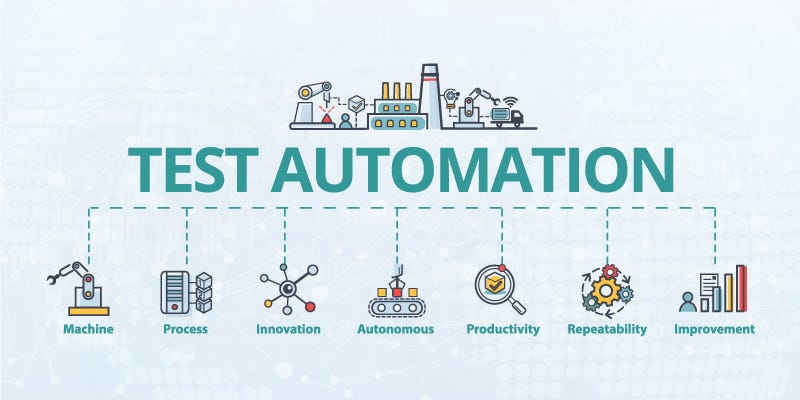Automation Testing Structures: Simplifying Complicated Testing Situations
Automation Testing Structures: Simplifying Complicated Testing Situations
Blog Article
Ensuring Success in Automation Evaluating: Key Metrics, Challenges, and Solutions Every QA Group Need To Know
In the realm of software application quality control, the landscape of automation screening is ever-evolving, demanding a precise technique to make sure seamless procedures. Secret metrics function as the compass assisting QA teams through the substantial surface of test automation, dropping light on progress and areas for enhancement. However, challenges impend big, frequently casting shadows on the path to success. By comprehending these obstacles and executing efficient services, QA teams can browse via complexities with finesse. The trip to mastering automation testing is led with nuances that need an eager eye for monitoring, evaluation, and continual enhancement. automation testing. As the market thrusts forward, the quest for optimal efficiency in automation testing remains a constant search, prompting QA groups to outfit themselves with the understanding and strategies crucial for accomplishment.
Relevance of Trick Metrics
Recognizing the relevance of crucial metrics is important for evaluating the performance and effectiveness of automation screening procedures. Secret metrics work as measurable measures that offer valuable insights into numerous facets of the testing procedure, such as test coverage, test execution time, problem density, and test instance efficiency. By analyzing these metrics, QA teams can identify bottlenecks, inadequacies, and locations for improvement within their automation screening structure.
One critical facet of crucial metrics is their capacity to track progress and keep track of the total health of the testing process (automation testing). They enable stakeholders to make enlightened decisions based on data-driven insights, which can cause more efficient screening methods and much better source allotment. Furthermore, vital metrics can aid groups established sensible objectives, determine the success of automation campaigns, and show the ROI of automation screening initiatives

Typical Obstacles Faced
Challenges generally experienced in automation screening procedures can considerably influence the total efficiency and effectiveness of QA teams. One of the major obstacles is the option of the best examination cases for automation. Not all examination situations appropriate for automation, and choosing the incorrect ones can cause lost time and sources. Furthermore, keeping examination manuscripts can be a challenging task, especially as the application undertakes regular modifications. Test manuscript maintenance needs continuous updates and modifications to guarantee they mirror the existing performance accurately. Another usual difficulty is the preliminary financial investment needed for setting up automation structures and devices. This can be a barrier for some organizations, particularly smaller ones with limited spending plans. Furthermore, automation testing may not cover all elements of testing, such as functionality and customer experience screening, which still require hand-operated intervention. Overcoming these obstacles needs appropriate planning, tactical test case selection, durable upkeep processes, sufficient resources, and a clear understanding of the restrictions of automation screening.
Efficient Solutions for Challenges
To address the barriers experienced in automation screening, carrying out efficient services is necessary for enhancing the performance and efficiency of QA teams. click to find out more One crucial option is to purchase durable training programs for QA teams to guarantee they have the required skills to efficiently use automation tools. Training can link knowledge gaps, improve understanding of automation frameworks, and boost scripting capabilities, inevitably resulting in a lot more reliable test creation and execution.
One more important service is to establish clear interaction channels within the QA group and with other stakeholders, such as programmers and task managers. Effective interaction aids in aligning assumptions, sharing progress updates, and immediately dealing with issues or obstructions that might arise during the automation screening process.

Surveillance and Evaluation Methods
Applying reliable tracking and analysis strategies is important for making certain the success and efficiency of automation screening processes. By using tracking tools, QA teams can track the performance of examination scripts, recognize traffic jams, and determine areas for renovation. Real-time monitoring enables quick detection of problems, allowing fast reaction and resolution. Furthermore, assessing examination outcomes and metrics provides important understandings into the top quality of the software program being checked and the performance of the screening approach.
One key strategy in monitoring and evaluation is the usage of dashboards that settle appropriate metrics and KPIs in a visually obtainable style. These control panels use a comprehensive introduction of test execution status, examination insurance coverage, defect patterns, and other crucial details. On a regular basis assessing and examining these control panels can help QA teams make educated decisions, focus on tasks, and maximize testing efforts.
In addition, executing automated signals and notices based upon predefined limits can enhance positive tracking and prompt treatment. By establishing notifies for performance discrepancies or examination failings, groups can attend to issues immediately and stop them from escalating. Generally, tracking and evaluation methods play an essential role in guaranteeing the effectiveness and success of automation testing read this article initiatives.
Continuous Improvement Methods
Enhancing the effectiveness of automation screening procedures requires the constant improvement of techniques and methodologies. One key method to enhancing automation testing procedures is to carry out regular reviews and retrospectives.

Verdict
In conclusion, it is essential for QA groups to comprehend the crucial metrics, challenges, and solutions in automation screening to ensure success. By thoroughly checking and examining information, executing efficient services to typical challenges, and constantly improving methods, QA teams can enhance their screening procedures and supply premium software. Complying with these techniques will eventually cause extra effective and reliable automation testing methods.
By examining these metrics, QA groups can identify bottlenecks, inadequacies, and areas for renovation within their automation screening framework.
In addition, vital metrics can aid groups set sensible objectives, determine the success of automation efforts, and demonstrate the ROI of automation testing initiatives.
Obstacles frequently run into in automation testing processes can dramatically impact the general effectiveness and efficiency of QA teams. Automation testing might not cover all aspects of testing, such as use and user experience testing, which still call for hand-operated intervention.In final thought, it is critical for QA groups to understand the key metrics, difficulties, and remedies in automation screening to make certain success.
Report this page